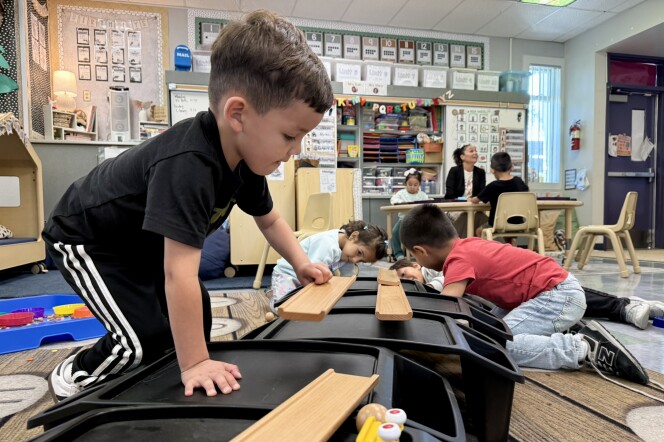With our free press under threat and federal funding for public media gone, your support matters more than ever. Help keep the LAist newsroom strong, become a monthly member or increase your support today.
UC Schools Are Seeing A Sharp Rise In CalFresh Enrollment

On Tuesday, UCLA student volunteers and staff stacked a table with free snacks and helped students start the process of enrolling in the food benefits program CalFresh. Gina Basile, a third-year studying dance and education, dropped by to see if they could help her figure out why she hadn't been able to use her CalFresh debit card, which she got in late January.
Ten percent of California Community College students and nearly 12% of University of California undergraduate students are enrolled in the CalFresh food benefits program, according to a new report from the California Policy Lab. For the UCs, that number is a jump from a decade ago — with a pivot upward in 2016 that the report suggests is tied to increased funding for the UC Basic Needs Initiatives:
The report also found that enrollment rates were generally higher among Black, Latino and Native American students, and among students who are the first in their families to attend college.
CalFresh provides low-income students with up to $250 per month to spend on groceries. The state has estimated that as little as 18% of eligible college students are enrolled in the safety net program, even though a much larger share of students report having trouble paying for food.
"The opportunity to have these benefits has been sort of life-changing, but I haven't been able to access them," Basile said. "It's really frustrating and really scary." Basile said she and her roommates all work minimum wage jobs, which don't pay enough to support off-campus living, even with her financial aid package.
"I thought that would be enough for me until I actually started living on my own and really got a sense of my own financial responsibility," said Basile, who is the first in her family to go to college. "Also this is my first time I moved away from home and so I just want to make sure that [my parents] know that I'm OK."
Food Insecurity 'Pretty Rampant' Among College Students
Elise Dizon-Ross is a co-author of the CPL report, which she said is the first comprehensive look at which California college students are using the food assistance program, known at the federal level as the Supplemental Nutrition Assistance Program (SNAP). "We knew food insecurity was pretty rampant among college students but we didn't know how many students were actually accessing these benefits," she said.
Everybody deserves to eat.
Dizon-Ross noted the wide variation in CalFresh enrollment on different campuses — for example, from a low of 7.8% of undergraduates at UC Riverside to 21% at UC Santa Barbara and 21.5% at UC Merced. She said this is likely due in part to the number of eligible students but also to the level of campus outreach and administrative support to get eligible students signed up.
Among other local UCs, just over 8% of Irvine and Los Angeles students are enrolled.
The data, which is from the 2019-2020 academic year, also showed:
- CalFresh enrollment among community college students was highest in the Central Valley (17%) followed by the Inland Empire (12.7%).
- 9.5% of community college students in the greater Los Angeles area were enrolled in CalFresh.
- 25.2% of Black community college students were enrolled in CalFresh, the highest of any racial/ethnic group.
- 27.1% of federal Pell Grant recipients and 23.9% of state CalGrant recipients at UC campuses were enrolled in CalFresh.
- 26.8% of first-generation college students on UC campuses are enrolled in CalFresh, compared to 10.6% non-first-generation.
- At 31.6%, foster youth are the group most likely to be in CalFresh across campuses.
- 4% of UC graduate students are enrolled in CalFresh — but the percentage jumps to 33% at UC San Francisco, which only serves graduate students.
Dizon-Ross said the high rate of CalFresh enrollment at UC San Francisco was likely due, in part, to strong support from campus administration.
Among students, there's a "sort of stigma and fear around the program," she said. "One of the things we heard when we talked to people at UCSF was that the messaging around CalFresh was just so commonplace, that they were really emphasizing, 'Hey, it's expensive to be a student here, like, everybody should try to get these.' … They just made it feel like it's such a common thing that it really reduces some of that stigma and fear."
Meal Plans Don’t Cover Every Meal
Nicole Nukpese, associate basic needs manager at UCLA's Community Programs Office, said most of the students she and colleagues help enroll in CalFresh live off-campus, but that many students who have on-campus meal plans need the extra help but don't qualify for benefits. "We tend to see that trend, that students who are very low-income tend to have the 11 meal plan [the most basic plan, which doesn't cover weekends], which is just not enough to eat every single day on campus."
Ginnie Tran, a fourth-year UCLA student, said she experienced this herself when she lived on campus. Tran, who is also a CalFresh recipient, said she recently had an encounter that brought home public misperceptions about recipients of the safety net program when she used her CalFresh Electronic Benefits Transfer (EBT) card at a grocery store. She said the cashier implied that college students shouldn't need benefits because they get help from their parents.
"It was a reminder that stigma still exists and that's why we're here," Tran said. “We want to destigmatize food insecurity as much as possible, because it's not something that people should be ashamed of. Everybody deserves to eat."








